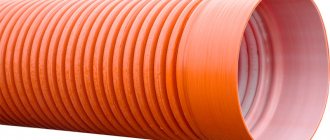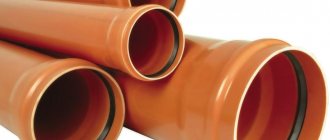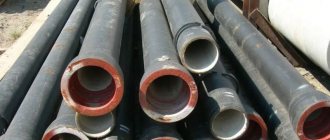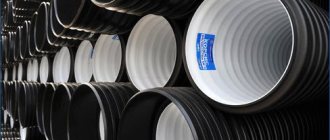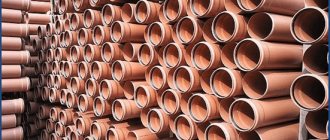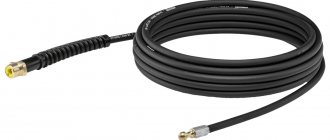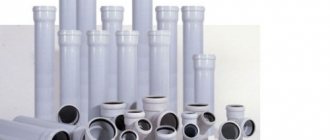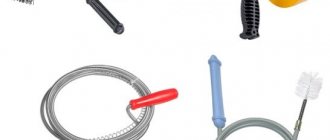To seal and strengthen pipe joints, sewer pipe seals are used. They protect the pipeline from leaks and the penetration of insects or rodents into the system. In addition, seals help to connect lines made of another material with a large difference in diameter to the system, acting as an adapter.
There are several types of sealing elements made from different materials. They are needed for installation in certain areas of the system; they cannot be used for other purposes (with rare exceptions). The design of the seals is simple, the operating efficiency is high. Let's take a closer look at them.
Sealing with rubber seals
Rubber seals for sewer pipes are most often used. They are easy to use, reliable and durable. They are used when installing sewerage systems in country houses and apartments, industrial buildings. The composition of rubber seals includes the following substances:
- rubber compound;
- rubber;
- polyurethane;
- silicone;
- paronitis
The result is durable, elastic rubber seals that ensure tightness and reliability of sewer pipe connections. The products are resistant to temperature changes, aggressive chemicals, non-concentrated acids and alkalis.
Rubber seals are classified depending on their purpose. They can be universal, rod, or piston. Three-lobe seals ensure a smooth transition from a cast iron pipe to a plastic one.
Rubber cuffs have a number of advantages. They are inexpensive, reliable, durable, and prevent groundwater from entering the sewer system. Thanks to the seal, the wastewater does not escape to the outside, and there is no unpleasant odor in the area.
Recommendations from experts
If the reason why pipes are leaking is a broken joint seal, you should:
- Dry the joint thoroughly. Clear away debris, blockages, old sealing substances (cement, glue). Choose what to seal the sewer pipe with (the joint of an apartment sewer pipe can be sealed with linen wrap). Sealing the bathroom pipe. Time to dry the element - at least 5 hours (it is not recommended to use the sewer during this time).
The reason why the sewer leaks is a crack in the coating. If the problem is that the solution is cracked, it is recommended:
- Dry the area where the pipe element is leaking. Choose what to cover the damaged area with (leakage can be eliminated with silicone, epoxy solution, liquid rubber, plasticine).
Before you repair a crack in a cast iron sewer pipe, you will need a heat gun. Shallow longitudinal cracks that expose a cast iron pipe to leakage most often occur against the background of frequent temperature changes. In such a situation, experts recommend degreasing and drying the crack with a hair dryer. The system can be sealed with sealant.
Then it is recommended to lay a heat insulator. Through cracks in the cast iron sewer system are sealed with a special two-component glue (cold welding method). After hardening, the seam can be sanded and painted over. The joints of cast iron elements are processed using: spun windings; sediment of strands; the use of asbestos cement and its solutions.
Practice using cuffs
Using cuffs, plumbing equipment (sinks, sinks, bathtubs, toilets, etc.) and household appliances (washing machines, dishwashers) are connected to the sewer network, and sewer pipes are connected. Plastic is connected to plastic using special fittings equipped with rubber sealing rings, and cast iron is connected to plastic using either adapters, couplings, or just cuffs.
To join cast iron and plastic pipes, both external and internal cuffs are used (for socketed and socketless structures). They work in stages:
- clean the connecting part of the cast iron pipe - it must be absolutely clean to ensure proper adhesion of the sealant;
- apply sealant to the cuff and insert it into the socket;
- A plastic pipe is inserted into the cuff.
If pipes have to be cut, this must be done correctly - the cut must be smooth (no nicks, even if they seem microscopic and are difficult to detect). After cutting, the part is chamfered.
In terms of the procedure for joining smooth pipes, it is not much different from socket pipes - the sealant must be applied to the collar on both sides, since the coupling is placed on top of it.
Scheme for installing a cuff on a sewer pipe (connection of smooth pipes)
Siphon connection
For this purpose, the use of a sealing collar is mandatory (there is always water in the siphon - it serves as a kind of seal). There are no difficulties in connecting the siphon - you can easily do it yourself without any special knowledge. First, the siphon itself is assembled according to the instructions (the accompanying documentation must be available, otherwise you should not buy the equipment: the configuration is different, and the assembly instructions vary accordingly). Then connect the pipe:
- to the siphon;
- to the sewer (simply inserted into the fitting hole intended for this purpose).
If the fitting on the riser is equipped with an O-ring, the collar is used only to connect the pipe to the siphon.
Sealing of cast iron structures
To seal the joints of cast iron pipes with your own hands, use tarred tow made of flax or jute fiber. The work is carried out according to the following algorithm:
- Wind the strands around the end of the pipe.
- The structure is inserted into the socket and the fiber is compacted with a special tool—chasing.
- The voids are filled with a solution of Portland cement in a ratio of 9:1 or filled with a viscous sealant.
Tow fills the joint to 2/3 of the height. When wet, the strands swell, taking up all the available space. You can use a mixture of dry asbestos fiber and cement in a 1:2 ratio. Before use, mix the ingredients with water.
Caulking the joints of cast iron pipes with tow and filling with polymer sealant
What is needed to organize internal sewerage
The internal sewer system collects wastewater from throughout the house and discharges it into the riser.
Sewerage accessories include:
- water seals connecting plumbing fixtures to the pipeline;
- a pipeline that discharges wastewater from the floor into the collector;
- ventilation tube;
- actually, the riser itself;
- sewer bed - a horizontal section of the pipeline through which wastewater flows further from the riser.
When laying pipes, you will need such shaped elements as revisions, tees, elbows, plugs, etc. Without them, it is impossible to ensure drainage according to all the rules.
Shaped elements
Shaped parts for sewerage can otherwise be called connecting parts; they are produced in the following configurations:
coupling - a short piece of pipe with sockets on both sides. Used to connect 2 parts of the pipeline;
adapter (reduction) – used to connect pipes of different diameters. Reduction can be coaxial or eccentric;
tee - this element is indispensable in situations where you need to create a branch extending from the main sewer system, for example, when laying out floors with your own hands;
revision - the same tee, only the outlet is closed with a plug, and the branch itself is small. Used when the sewer is clogged to clean it;
crosspiece - the purpose is the same as that of a tee, but with its help a more complex unit is organized;
- elbow
(bend) – used when turning the pipeline; - non-return valve
- necessary in emergency situations, thanks to it wastewater will not flow back in the event of a malfunction of the drainage system;
plug - during repairs, used to block the sewer.
Sewer fittings are a vital element when laying out the system. Without them, it is impossible to install pipes across the floor or connect them to the riser.
Features of connecting plumbing fixtures
The connection of any plumbing fixture must be organized so that unpleasant odors from the sewer do not leak into the room. The simplest method is to connect through a water seal (or siphon).
The siphon looks like an ordinary pipe in the shape of the letter S, thanks to the water plug, protection against odors is guaranteed. If you do not plan to live in the house regularly, for example, in a country house, then you can consider other methods of protection against odors (dry sewer siphon).
Sewer repair
When repairing the above elements will not be enough. In particular, when replacing a section of a pipeline, sewer pipes will be needed.
There are often situations when part of the old pipe is rotten or simply cracked; in this case, it will be necessary to replace not the entire drainage system, but only a small section. In order to connect the new pipe to the existing drainage system, pipes are used.
Externally, the sewer pipe looks like a small section of pipe, on one side it is smooth, and on the other there is a socket. Accordingly, on the one hand, the connection is made using a socket method, on the other - in a joint, using a coupling.
Sometimes, when repairing an old cast-iron sewer, it is necessary to join plastic and cast-iron pipes. At the same time, to achieve the required tightness, one sealant is not enough. First, you will need to insert a rubber cuff into the cast-iron socket and then a plastic pipe into it.
Tightness of the junction of plumbing fixtures and pipelines
A sewer seal is used to reduce the likelihood of leaks in the area between the plumbing fixture and the pipeline. Externally, the cuff looks like a rubber ring that is placed over the joint.
To achieve greater elasticity, the cuffs do not contain polymers; only natural rubber is used for their production. True, during operation, because of this, it is necessary to use lubricant so that the rubber does not crack.
If you plan to use a rubber cuff, you will also need lubricant for sewer pipes. If you try to insert the end of the pipe into the cuff without lubrication, the rubber can be easily damaged. And after installation, the cuff must be periodically lubricated.
As for the specific lubricant, there are many options, some prefer to use automotive lubricant, which is used for rubber inserts in car doors in the winter. But even ordinary plumbing lubricant can keep the rubber safe and sound.
Types of sealants
Sealing of sewer pipes can be done with the following materials:
- reinforced aluminum adhesive tapes;
- silicone sealants;
- mastics from various manufacturers;
- polymer cement solutions;
- sanitary winding;
- epoxy resin;
- technical sulfur.
To choose the right sealant for sewer pipes, you need to know the material from which the drain is made. Silicone compounds and reinforced tapes are suitable for lightweight plastic pipes PVC, PEX, HDPE, etc. If you have to work with metal (steel or cast iron), you need to use something serious. It is also important to consider for what work the solution is purchased.
The joints of PVC plastic pipes are sealed with lightweight silicone, which is unlikely to cope with an emergency leaking sewer. It is also important to follow the instructions. It describes the optimal conditions under which sewer pipes should be sealed. For example, let's take the optimal conditions for curing silicone sealant (this is room temperature, at which it dries for about 4 minutes). When working in cold weather, the hardening time is significantly longer.
There is a need to purchase another type of sealant - frost-resistant silicone. We'll talk about the nuances of using different materials below.
How to seal pipes
Rubber sealant for sewer pipes is used most often. The sequence of installation work depends on whether the internal or external sewage system is being installed. When arranging an internal pipeline, installation consists of the following steps:
The connection is sealed and the pipeline is now ready for use. It should be remembered that if silicone sealant is used, it should not be applied to the outside of the sewer pipe.
If sealing of the external pipeline is required, installation work is carried out in the following sequence:
- the sealing compound is applied to the inner surface of the rubber cuff;
- the fitting is put on the pipe;
- When the sealant hardens, you can connect the pipeline.
Sealing sewer pipe connections is an important step when performing sewer installation work. It is at the joints that blockages, leaks and other unpleasant problems most often form, which help reduce the service life of the sewer system. You can prevent any problems if you follow the advice of professionals and carry out all work carefully and diligently.
In order for the sewer system to function efficiently and effectively, it must be installed correctly. It’s easier for residents of multi-storey buildings who install only an internal pipeline. But owners of country mansions will have to take care of laying external sewerage and arranging an autonomous system.
Sewage installation consists of several stages:
- drawing up a sewer system project;
- procurement of materials;
- pipe connection;
- sealing joints;
- sealing connections.
Sealing sewer pipes is necessary to avoid leaks and breakthroughs during system operation. Most often, rubber cuffs are used to seal the joints of plastic sewer pipes. Seals prevent water from getting in or out and protect the sewer from the penetration of insects and small rodents. High-quality sealed connections are a guarantee of long-term and efficient functioning of the sewer system.
Sealing concrete rings
*
To prevent sewer septic tanks from becoming a source of environmental pollution, it is necessary to thoroughly waterproof the concrete rings. Various sealing methods are used:
- plastering the inner surface with moisture-resistant compounds;
- spraying an elastic film on the outside using a special apparatus;
- coating with cold or hot mastics;
- pasting with roll materials;
- impregnation with penetrating solutions;
- sealing joints with bentonite expanding clay and bitumen pastes.
Coating waterproofing of wells
A good effect is achieved by treating the rings with bitumen mastics and additional protection using a clay lock. The clay around the septic tank is poured in layers and compacted with a hand tamper.
What types of cuffs are there for sewer pipes?
This is predominantly a round wide o-ring, sometimes with a corrugated part. The cuffs are internal and external. Internal ones are used to connect socket structures, external ones - for smooth pipes (in addition to the seal, a coupling is installed).
Sealing cuffs with corrugated part
Cuffs are most often made of rubber - an elastic material that fits tightly, providing a reliable flexible connection. The shape of a part depends on its function.
Rubber cuffs
Eccentric cuff
The eccentric cuff consists of pipes connected to each other with an offset, that is, the centers of both parts are in different planes. Traditionally, the part is called a cuff, but this is a special shaped part for connecting to the toilet network. It is equipped with O-rings and does not require the use of sealant (with the exception of connection to an old cast-iron riser, when sealant is used for greater reliability, given the difference in materials).
Unfortunately, due to too much displacement of the connected elements, it is not always possible to use the eccentric cuff (although some craftsmen manage to insert one into the other, building a strange structure) - in such cases, the toilet is connected using a corrugation.
Eccentric cuff
The parts come in different configurations, but sometimes such a displacement is required that connection with their help is impossible - in such cases a corrugation is installed.
Pleated cuff
The corrugation is similar to an eccentric cuff, but the implementation of the displacement is different - it is achieved through a flexible corrugated sleeve, and not by positioning the parts relative to each other. Thus, the displacement can be large, but it is necessary to set the desired bending angle of the corrugated part so that the drains flow freely (otherwise blockages are inevitable).
Connection via corrugation
The main advantage of corrugation is flexibility. Thanks to this property of the part, it is almost always possible to connect a toilet to the sewer without errors. The main disadvantage is the short service life. Due to the same flexibility, the walls quickly wear out and the part becomes unusable. When choosing corrugation, you need to give preference to thick-walled, reinforced.
Reinforced corrugation
Installation is theoretically simple (the parts are simply inserted into each other according to the attached instructions), but we do not recommend installing them yourself (unless you have the skills): the cuff functions normally under certain conditions (bending angle, slope, stretch length), and if they are not created, the system will not work will be disrupted (which can lead to floods due to blockages).
So you won’t be able to read a newspaper/memoir while sitting on the toilet, looking out of the window from time to time - or you’ll have to erect a plumbing miracle on a pedestal and screw a ladder to it (here it’s not far from the attic window).
On a pedestal
There is a solution to this problem as well - installing a pumping system that forcibly sends wastewater into the sewer system. However, such drastic changes will require permission for redevelopment, and this is:
- development of a project (yes, just to move the toilet a few meters);
- payment for the project;
- its approval by the authorities and everything related to it;
- payment of the approval fee;
- the commission accepting the transfer of equipment (they look at how far they have moved away from the project, if they have moved away);
- payment of commission fees.
We recommend using the cuffs exclusively for their intended purpose - for connection and nothing more.
Everything is easy in the text - the text cannot convey the effort made. However, we all know what is transported by sewer pipes (that is, what will flood an apartment/house when incorrectly installed cuffs cause a flood), and therefore, when it comes to sewerage, we strongly recommend that you contact specialists, even those with restless hands
Especially when it comes to cast iron risers: cast iron is fragile - it must be handled with extreme caution
How to install the cuff correctly
The easiest way is to connect a corrugated pipe to a plastic riser. This is due to the specifics of such a joint: it is quite easy to insert an elastic band into the socket, after which the tip of the flexible pipes is placed in the hole.
A more complex option is to connect a plastic riser to a cast iron one. This is due to the fact that for a high-quality joint it is necessary to almost perfectly clean the cast iron socket from old residues of sealants and other possible contaminants.
It is not particularly difficult to join the sewer section of pipes with the presence of internal sealing collars.
The uncut type pipe end easily and simply penetrates into the socket area, in which the seal must first be correctly placed. When a section of the highway is cut, then at its end it is necessary to make a cone-shaped edge, after which the elastic will easily take its place. Plain water can be used as a lubricant.
Risers with a diameter of 110 mm (it is best to buy those manufactured by Rossiya) are more difficult to connect, even if you moisten the joint with water. Therefore, to facilitate the installation of the connecting collar, it must be lubricated with automobile oil and other available lubricants that will facilitate the installation process.
Similarly, it is possible to install valves for differential pressure regulators.
Since our hardware stores have a sufficient number of connecting adapter sleeves for metal, polypropylene, and plastic, it is not particularly difficult to assemble the pipeline hermetically. You just need to correctly determine the internal diameters. After this, connecting cast iron to plastic, plastic to plastic, or making any other connection will not be a problem.
Rubber cuffs for sewerage can be made from different materials, and there are also different types of devices. Hydraulic seals are used in industry, for equipping sewage systems in private houses, cottages and apartments.
Cuffs for cast iron sewers are made of polyurethane and rubber compounds such as rubber, paronite, silicone and rubber. In production, only 100% rubber is used, no polymer is mixed. Thanks to this composition, high elasticity, strength and tightness of fastening with the connected parts are ensured. Polymer and rubber also provide resistance to increases and decreases in temperature, are resistant to aggressive substances, and can be used when exposed to acids and with increased rigidity of working resources.
The sealing cuff for sewerage also comes in different types:
- rod;
- piston;
- universal (for rods and pistons).
Also, the rubber sealing cuff for sewerage can be internal or external. The internal seal is used in cast iron pipes to connect plastic pipes with different diameters. Also used to connect a corrugated hose to the drain of household plumbing fixtures (for example, connecting to the sewage system of a washing machine or dishwasher). The external seal, in turn, is used to connect to a socketless sewer structure.
There is also a three-leaf transitional sewer cuff, which facilitates the transition from a cast iron pipeline to a plastic one.
How to seal threaded heating connections
7.1. Gaskets
Many people use end gaskets to seal heating pipes. This method is technologically the fastest, but the quality of sealing could be better.
The thing is that during assembly of the structure, the gasket is strongly pressed by the thread and the joint density may suffer slightly, since the part opposite to the external thread has a slight narrowing.
But to make the joint tighter and more reliable, they use a paronite or fluoroplastic part, after installation of which the entire structure must be securely screwed together. Although it is not always possible to achieve transitions without narrowing with this method.
Taking this into account, a gasket is often installed when sealing sensors and instruments for measuring pressure or temperature, where the hydraulic resistance is not very large. True, experienced plumbers, for greater confidence and reliability, use additional sealing in the form of, for example, tow with red lead. They explain this by saying that we are still dealing with hot water, which is not always safe.
7.2. FUM tape
Since the coefficient of friction of the fluoroplastic tape is low, it can be used to assemble an entire threaded structure without much effort. The advantages of the material include high chemical resistance and long service life.
Like all materials, FUM tape has some disadvantages:
Winding FUM tape
- during the assembly process it can tear into separate pieces, or be twisted back out;
- cannot be used in connections with possible temperature deformations. The fact is that the tape has poor adhesion to metal, and if the joint “plays”, the seal may be squeezed out;
- can act as a reliable sealant for threaded connections with a diameter of only up to 25 mm. Therefore, using such material it is impossible to completely install a heating system.
7.3. Tow
This simple and cheap material has been a reliable sealant for decades. For impregnation, lead minium on drying oil or ordinary oil paint are most often used.
Despite the emergence of good modern sealants, flax strands have been and remain the leader among the most reliable sealants. Due to its positive qualities, the material is often used in the installation or repair of heating systems.
Tow is different:
- reliability;
- seal quality;
- cheapness;
- ease of use.
The disadvantages include:
- limited service life;
- tendency to dry out;
- the need to have certain skills in winding and coating.
Elements of external sewerage
In addition to the pipes themselves, revisions and bends, the outer section of the drainage system also includes several specific elements. In the case of an autonomous sewer system, wastewater needs to be stored somewhere while it is being cleaned, so you will need to build a septic tank, or better yet, a septic tank.
Construction of a settling tank
Sewage settling tanks are a regular pit in which wastewater settles, large particles settle to the bottom, after which the clarified wastewater moves to the next stage of treatment. Externally, the sump looks like a pit with reinforced walls and bottom (or a special container).
If the sump is built independently, then the instructions look like this:
- a hole is dug in the ground (depth approximately 2.5 m, cross-section at least 2.0x2.0);
- a cushion of a layer of gravel is poured onto the bottom of the pit, on top of which a sand layer is placed;
- after this you need to seal the bottom and walls of the pit. You can build formwork, place a reinforcement frame in the pit and fill the walls and bottom of the pit with concrete mixture; you can reinforce the walls with brickwork;
when the concrete hardens, all that remains is to concrete the ceiling and arrange ventilation for the sump.
You can go the other way; instead of labor-intensive concreting, many use large-volume plastic containers for sedimentation tanks. These can be Eurocubes, plastic barrels, metal barrels in which paint and varnish materials were previously stored. The price of installing a sump in this case is low, but tightness is ensured.
There are also budget options for settling tanks. From ordinary truck tires, you can build a septic tank suitable for irregularly used sewage systems.
Septic tanks stand apart. Externally, such a container looks like a large barrel with ventilation pipes, and the internal space is divided into separate zones: first, the wastewater settles, then through the overflow system the liquid enters the second section, where final cleaning occurs.
Fluoroplastic pipes and barrels for sewerage
Separately, it is worth mentioning fluoroplastic barrels for sewerage. PTFE itself is an interesting material. Pipes and barrels made from it can be used in the temperature range from -100ᵒС to +250ᵒС. In addition, fluoroplastic is strong and durable.
Note! Fluoroplastic is an inert material; it does not react even with very aggressive substances; in this indicator it even surpasses platinum and gold. Therefore, using it in ordinary sewerage is not entirely justified.
Most often, fluoroplastic pipes and barrels are used in the chemical industry.
Pros and cons of cuffs
The sealing rubber cuff for sewerage 100 has a number of advantages.
It is characterized by:
- reliability, which eliminates the possibility of water flowing out of the sewer line, since the plastic can be perfectly fixed in a cast iron pipe;
- ability to withstand sudden pressure changes ranging from 50 to 150 kPa;
- breadth of the model range. Since hydraulic seals come in different diameters, they can also be used to connect risers of different diameters;
- budget. The price of the seals is so low that it is completely affordable for the average citizen.
The negative aspects include the fact that in order to mount the cuff in the right place it is necessary:
- the presence of sockets at the ends of cast iron pipes;
- bring the inner surface to almost perfectly flat and smooth.
A sealing collar is necessary when connecting the siphon to the sewer system. You need to remember that you should first start assembling the siphon itself, and only after that – connecting the device to the main line.
Properties of sealing elements and materials of manufacture
For sealing to be effective, cuffs must have the following properties:
- elasticity;
- elasticity;
- ability to withstand temperature changes within certain limits;
- strength and long service life.
Rubber products fully possess these properties, therefore sealing couplings and cuffs for sewage pipes and transitional shaped elements are made of varieties of this material, such as:
- the actual rubber;
- paronitis;
- rubber;
- silicone
Sometimes manufacturers add polymer substances to the rubber composition, which makes rubber seals for sewer pipes more rigid, less convenient during installation work, but at the same time wear-resistant and durable.
Some types of cuffs, for example those that are equipped with adapter couplings for connecting the toilet flush to the sewer pipe, are made of polyethylene. In conditions of large diameter connecting holes (at least 110 mm) often of irregular geometry, this material demonstrates better tightness and wear resistance (rubber cuffs after dismantling have to be replaced with similar ones).
Nuances of work
To ensure high-quality sealing, you must first clean the surface of the pipe from dirt, then dry it.
The next step is to apply a primer layer, after which the surface is dried again. Next, tape is glued to the cylindrical product. It is wrapped around the problem area in the form of a spiral.
For better tightness, each new layer of self-adhesive material should cover half of the previous one. A few layers will be enough.
No folds should form when winding. Even small defects can cause a leak.
About bellows connections for mixers
Flexible connections to faucets have different options. One of the most popular is bellows-type eyeliner. It has a number of advantages in comparison with other similar devices.
4.1. Advantages
Among the many positive characteristics, the following can be highlighted:
- made from high quality stainless steel;
- reliably protected from water hammer;
- high-quality operation is possible for a long time;
- resistant to possible sudden temperature fluctuations, can fully function at temperatures up to 230-250⁰C;
- hygienically clean, safe for health, device;
- does not burn.
4.2. Flaws
There are several negative aspects associated with the use of bellows liner:
- the appearance of hum, noise, vibration processes of corrugated tubes;
- When several consumers are connected simultaneously, increased vibration is observed.
Interestingly, the larger the diameter of the liner, the less the hum becomes. Excess noise disappears with plastic sleeves.
The option of eyeliner with non-toxic rubber braid is also quite popular.
If the sewer line becomes clogged, residents of the lower floors will suffer from contaminated water that pours out through the toilet or bathtub. This problem can be solved quite simply: install a check valve. This device can only pass wastewater in one direction and eliminates the possibility of the medium moving in the opposite direction. The principle of its operation is the same as a similar brass device that is used in drinking water lines.
